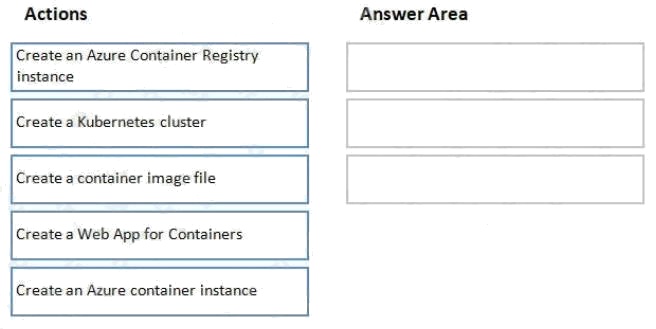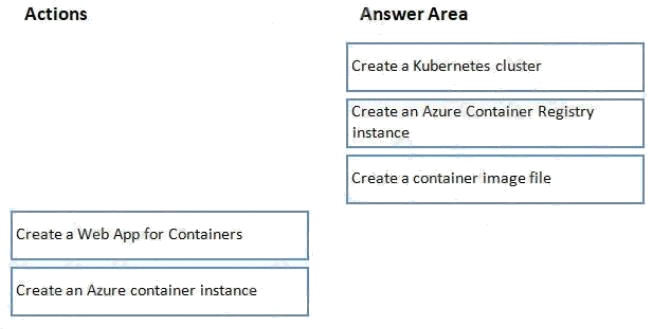microsoft ai-100 practice test
Designing and Implementing an Azure AI
Note: Test Case questions are at the end of the exam
Question 1 Topic 3, Mixed Questions
You are developing an AI application for your company. The application will use Microsoft Azure Stream Analytics.
You save the outputs from the Stream Analytics workflows to the cloud.
Which of the following actions should you take?
- A. Make use of a Hive table in Azure HDInsight
- B. Make use of Azure Cosmos DB
- C. Make use of Azure File storage
- D. Make use of Azure Table storage
Answer:
C
Explanation:
Reference:
https://docs.microsoft.com/en-us/azure/stream-analytics/stream-analytics-define-outputs
Question 2 Topic 3, Mixed Questions
Your company is about to deploy an Azure Machine Learning experiment. The company is concerned that the experiment
might not be adhering to GDPR regulations.
You have been instructed to do a review of the experiment's adherence to GDPR regulations. You must perform the review
as quickly as possible.
Which of the following actions should you take?
- A. Make use of Azure Policy
- B. Make use of Azure Security Center
- C. Make use of Azure Log Analytics
- D. Make use of Compliance Manager
Answer:
D
Explanation:
Reference: https://azure.microsoft.com/en-us/blog/new-capabilities-to-enable-robust-gdpr-compliance/
Question 3 Topic 3, Mixed Questions
You have developed an AI application for your company.
You want to prepare the application for deployment to Kubernetes.
Which three of the following actions should you perform? To answer, move the selected actions from the list of actions to the
answer area and rearrange them in the right order.
NOTE: Each correct selection is worth one point.
Select and Place:
Answer:

Explanation:
Reference: https://docs.microsoft.com/en-us/azure/aks/tutorial-kubernetes-prepare-app
Question 4 Topic 3, Mixed Questions
You have deployed several Azure IoT Edge devices for an AI solution. The Azure IoT Edge devices generate measurement
data from temperature sensors.
You need a solution to process the sensor data. Your solution must be able to write configuration changes back to the
devices.
You make use of Azure Notification Hub.
Does this action accomplish your objective?
- A. Yes, it does
- B. No, it does not
Answer:
B
Explanation:
Use Microsoft Azure IoT Hub instead.
Reference:
https://azure.microsoft.com/en-us/resources/samples/functions-js-iot-hub-processing/
Question 5 Topic 3, Mixed Questions
You have deployed several Azure IoT Edge devices for an AI solution. The Azure IoT Edge devices generate measurement
data from temperature sensors.
You need a solution to process the sensor data. Your solution must be able to write configuration changes back to the
devices.
You make use of Microsoft Azure Event Hub.
Does this action accomplish your objective?
- A. Yes, it does
- B. No, it does not
Answer:
B
Explanation:
Use Microsoft Azure IoT Hub instead.
Reference:
https://azure.microsoft.com/en-us/resources/samples/functions-js-iot-hub-processing/
Question 6 Topic 3, Mixed Questions
You have deployed several Azure IoT Edge devices for an AI solution. The Azure IoT Edge devices generate measurement
data from temperature sensors.
You need a solution to process the sensor data. Your solution must be able to write configuration changes back to the
devices.
You make use of Microsoft Azure IoT Hub.
Does this action accomplish your objective?
- A. Yes, it does
- B. No, it does not
Answer:
A
Explanation:
Reference:
https://azure.microsoft.com/en-us/resources/samples/functions-js-iot-hub-processing/
Question 7 Topic 3, Mixed Questions
You company's developers have created an Azure Data Factory pipeline that moves data from an on-premises server to
Azure Storage. The pipeline consumes Azure Cognitive Services APIs.
You need to deploy the pipeline. Your solution must minimize custom code.
You use Self-hosted Integration Runtime to move data to the cloud and Azure Logic Apps to consume Cognitive Services
APIs.
Does this action accomplish your objective?
- A. Yes, it does
- B. No, it does not
Answer:
A
Explanation:
A self-hosted Integration Runtime is capable of running copy activity between a cloud data stores and a data store in private
network.
Azure Logic Apps helps you orchestrate and integrate different services by providing 100+ ready-to-use connectors, ranging
from on-premises SQL Server or SAP to Microsoft Cognitive Services.
Reference: https://docs.microsoft.com/en-us/azure/data-factory/concepts-integration-runtime https://docs.microsoft.com/en-
us/azure/logic-apps/logic-apps-examples-and-scenarios
Question 8 Topic 3, Mixed Questions
You are developing the workflow for an Azure Machine Learning solution. The solution must retrieve data from the following
on-premises sources:
Windows Server 2016 File servers
Microsoft SQL Server databases Oracle databases
Which of the following actions should you take?
- A. Make use of Azure Data Factory to retrieve the data.
- B. Make use of Azure Databricks to retrieve the data.
- C. Make use of Azure Stream Analytics to retrieve the data.
- D. Make use of Azure Synapse Analytics to retrieve the data.
Answer:
A
Explanation:
Reference:
https://docs.microsoft.com/en-us/azure/machine-learning/studio/use-data-from-an-on-premises-sql-server
Question 9 Topic 3, Mixed Questions
You are designing an Azure Batch AI solution that will perform image recognition. The solution will be used to train several
Azure Machine Learning models.
You need to enable versioning for Azure Machine Learning models.
What should you do?
- A. Register the Azure Machine Learning models.
- B. Use Azure HDInsight cluster.
- C. Use Machine Learning experiments.
- D. Use Machine Learning pipelines.
Answer:
A
Explanation:
Model registration allows you to store and version your models in the Azure cloud, in your workspace. The model registry
makes it easy to organize and keep track of your trained models.
Reference: https://docs.microsoft.com/en-us/azure/machine-learning/studio/version-control https://docs.microsoft.com/en-
us/azure/machine-learning/how-to-deploy-and-where
Question 10 Topic 3, Mixed Questions
You are developing an AI solution that will use in-memory caching and a columnar storage engine for Apache Hive queries.
What HDInsight platform should you use?
- A. Apache Kafka
- B. Apache Spark
- C. Interactive Query
- D. Apache Storm
Answer:
C
Explanation:
Interactive Query provides In-memory caching and improved columnar storage engine for Hive queries.
Reference:
https://docs.microsoft.com/bs-latn-ba/azure/hdinsight/interactive-query/apache-interactive-query-get-started
Question 11 Topic 3, Mixed Questions
You are developing an application that uses an API pipeline. The application consumes and analyzes streaming data.
You API pipeline must perform face detection and sentiment analysis.
What actions should you take?
- A. Use the Computer Vision API in the pipeline.
- B. Use the Face API in the pipeline.
- C. Use the Text Analytics in the pipeline.
- D. Use the Video Indexer in the pipeline.
Answer:
D
Explanation:
Azure Video Indexer is a cloud application built on Azure Media Analytics, Azure Search, Cognitive Services (such as the
Face API, Microsoft Translator, the Computer Vision API, and Custom Speech Service). It enables you to extract the insights
from your videos using Video Indexer video and audio models described below:
Visual text recognition (OCR): Extracts text that is visually displayed in the video.
Audio transcription: Converts speech to text in 12 languages and allows extensions.
Sentiment analysis: Identifies positive, negative, and neutral sentiments from speech and visual text. Face detection: Detects
and groups faces appearing in the video.
Reference: https://docs.microsoft.com/en-us/azure/media-services/video-indexer/video-indexer-overview
Question 12 Topic 3, Mixed Questions
You company's developers have created an Azure Data Factory pipeline that moves data from an on-premises server to
Azure Storage. The pipeline consumes Azure Cognitive Services APIs.
You need to deploy the pipeline. Your solution must minimize custom code.
You use Azure-SSIS Integration Runtime (IR) to move data to the cloud and Azure API Apps to consume Cognitive Services
APIs.
Does this action accomplish your objective?
- A. Yes, it does
- B. No, it does not
Answer:
B
Explanation:
With Azure-SSIS Integration Runtime you would need to write custom code
Reference: https://docs.microsoft.com/en-us/azure/data-factory/concepts-integration-runtime https://docs.microsoft.com/en-
us/azure/logic-apps/logic-apps-examples-and-scenarios
Question 13 Topic 3, Mixed Questions
You company's developers have created an Azure Data Factory pipeline that moves data from an on-premises server to
Azure Storage. The pipeline consumes Azure Cognitive Services APIs.
You need to deploy the pipeline. Your solution must minimize custom code.
You use Integration Runtime to move data to the cloud and Azure API Management to consume Cognitive Services APIs.
Does this action accomplish your objective?
- A. Yes, it does
- B. No, it does not
Answer:
B
Explanation:
Azure API Management is a turnkey solution for publishing APIs to external and internal customers.
Reference: https://docs.microsoft.com/en-us/azure/data-factory/concepts-integration-runtime https://docs.microsoft.com/en-
us/azure/logic-apps/logic-apps-examples-and-scenarios
Question 14 Topic 3, Mixed Questions
You have created an AI solution that uses several PersonGroup objects.
One of the PersonGroup objects contains thousands of entries and cannot accept any new entries.
You want to be able to add new entries to the PersonGroup object. The PersonGroup object must be identifiable by all the
entries.
Which of the following actions should you take?
- A. Compress the entries from the PersonGroup object.
- B. Create another PersonGroup object with the same name.
- C. Migrate the PersonGroup to a LargePersonGroup object.
- D. Archive some of the entries from the PersonGroup object.
Answer:
C
Explanation:
LargePersonGroup and LargeFaceList are collectively referred to as large-scale operations. LargePersonGroup can contain
up to 1 million persons, each with a maximum of 248 faces. LargeFaceList can contain up to 1 million faces. The large-scale
operations are similar to the conventional PersonGroup and FaceList but have some differences because of the new
architecture.
Reference:
https://docs.microsoft.com/en-us/azure/cognitive-services/face/face-api-how-to-topics/how-to-use-large-scale
Topic 3, Implement and monitor AI solutions
Question 15 Topic 3, Mixed Questions
You are designing an Azure Batch AI solution that will perform image recognition. The solution will be used to train several
Azure Machine Learning models.
You need to recommend a compute infrastructure for the solution that minimizes the processing time.
What should you recommend?
- A. Compute optimized virtual machines.
- B. Memory optimized virtual machines.
- C. GPU optimized virtual machines.
- D. General purpose virtual machines.
Answer:
C
Explanation:
GPU optimized virtual machines are specialized virtual machines targeted for heavy graphic rendering and video editing, as
well as model training and inferencing (ND) with deep learning.
Reference:
https://docs.microsoft.com/en-us/azure/virtual-machines/windows/sizes-gpu